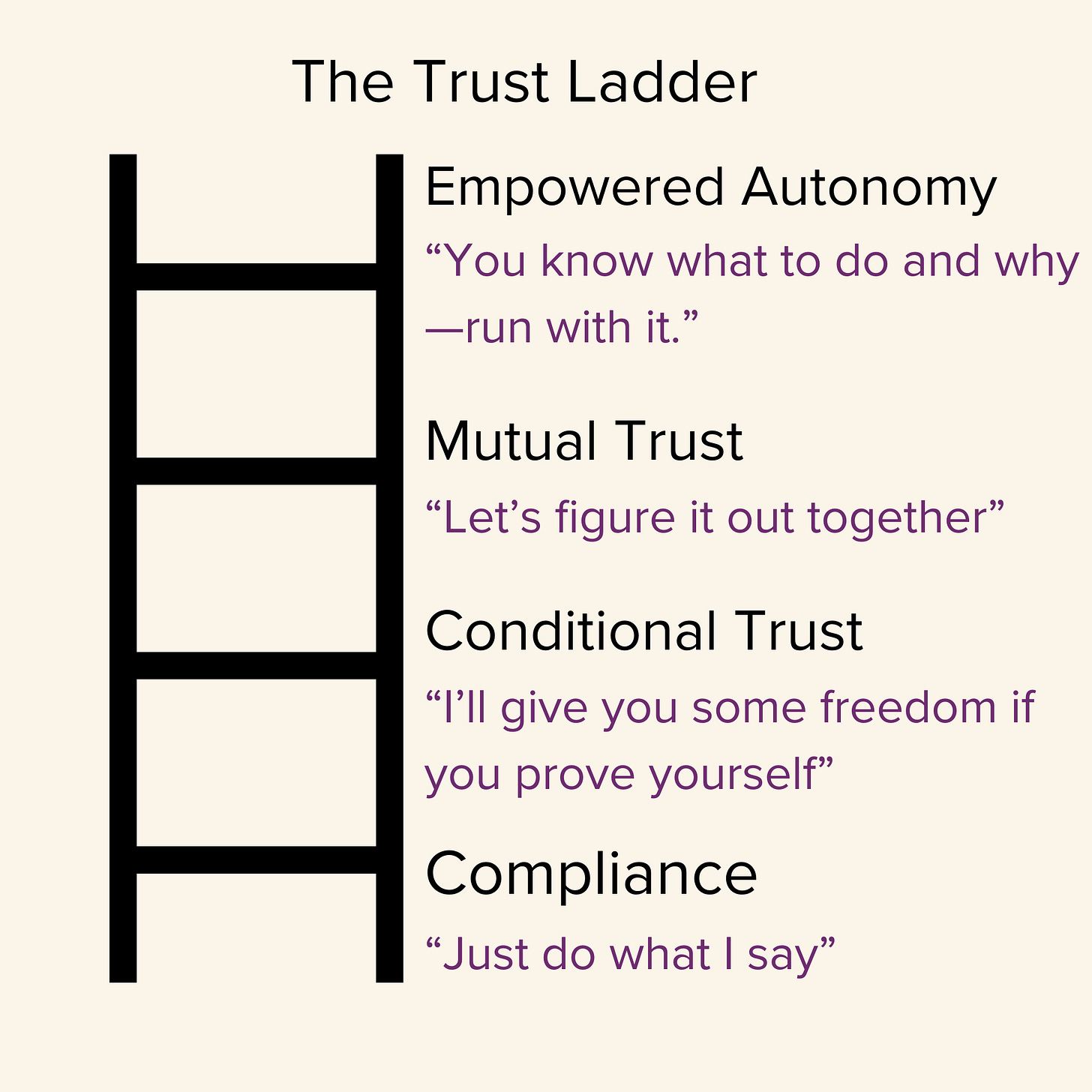When I met Mr. Banks, he was the kind of teacher you root for. Smart, mission-driven, deep love for his students. But he’d stopped trying to lead anything. Just came in, taught his classes, turned in lesson plans, and kept to himself.
“I just do what they want,” he told me once. “Keeps the heat off.”
This man wasn’t burned out. He was boxed in.
Every idea he offered was met with “we’ll get back to you.” Every initiative he participated in was rolled out and retracted by spring. Every year felt like a new experiment with the same outcome: do it the district’s way, document everything, and smile.
The school called it “tight systems.”
He called it survival.
The Real Problem: We Call Compliance Trust
Let’s be honest. We say we “trust” teachers—but often what we mean is, they’re doing what we told them to do.
In schools, that passes for alignment.
Trust is built when expectations are clear, feedback is ongoing, and autonomy is earned together—not given away.
That’s where the Trust Ladder comes in. It’s a simple framework to help schools see where they’re operating—and what’s required to move toward true empowerment.
The 4 Rungs of Trust
This is how people feel at each rung of this ladder:
Compliance: Controlled. Performative. Transactional.
Conditional Trust: Watched. Cautious. High-stakes.
Mutual Trust: Collaborative. Respectful. Adaptive.
Empowered Autonomy: Liberating. Supported. Accountable.
Why Compliance Can Be a Trap
Compliance becomes a trap when organizations focus on looking good—checking boxes, passing audits, completing forms—without actually improving the things those rules were created to protect: safety, equity, instructional quality, student learning.
In education, this trap looks like:
Teachers aligning lessons for the binder, not for the students.
Leadership teams running data meetings to meet the “protocol” instead of to understand trends.
Compliance walkthroughs that feel more like performance reviews than instructional coaching.
The Result
Reactive, Siloed Systems: Schools respond to mandates and crises, not strategy.
Distorted Incentives: Passing the walkthrough becomes the goal—not improving what happens during instruction.
Normalization of Deviance: Shortcuts get normalized. As long as nobody notices, we keep calling it fidelity.
Resource Drain: Documentation eats time that could’ve gone to feedback, collaboration, or actual teaching.
“Organizations are caught in a trap of working hard and hoping for the best... perhaps only one violation or breach away from mission failure.”
— Adapted from Lean Compliance
How Compliance Relates to Trust
Yes—compliance and trust are connected. But they are not the same thing.
Compliance provides a floor.
Trust builds the ceiling.
Breaking Free from the Compliance Trap
You don’t get to mutual trust or empowered autonomy by just “relaxing” the rules.
You get there by designing systems that make trust possible.
Here’s how:
✅ From Reactive to Proactive
Stop waiting for audits to drive improvement. Create feedback loops that surface risks before they become visible failures.
✅ Integrate Compliance into Instruction
Don’t bolt on checklists—bake expectations into coaching, PLCs, and shared team tools.
✅ Teach the Why, Not Just the What
Make sure teachers understand the purpose behind the practices—not just the requirement to implement them.
✅ Use Audits as Learning, Not Surveillance
Review systems together. Ask: Is this helping us grow, or just helping us report?
✅ Elevate Transparency Over Perfection
If people are scared to say, “This isn’t working,” you’re not building trust. You’re reinforcing fear.
So… Where Are You on the Ladder?
Here’s what to reflect on:
Are your teams compliant—or curious?
Is autonomy something people are allowed to have—or something they feel safe using?
Are you giving feedback that builds belief, or just checking off implementation?
If you’re still stuck in compliance and calling it trust—you’re not alone. But you are stuck, and you deserve better and so do your people.
Coming Next…
In Part 4, we’ll walk through the Trust Friction Curve—that moment when you finally give your team autonomy… and it gets messier before it gets better. (Spoiler: that’s normal.)
But for now, one question:
What would it look like to stop measuring whether people followed the rules—and start measuring whether the rules are helping them do great work?











This is brilliant, Jo!
It brings to mind my repeated experiences with institutions failing to meet even the compliance floor, most significantly as briefly documented here:
Musings on Defence Export Controls from a Dirty 🇨🇦 Foreign National:
https://open.substack.com/pub/digitalcanary/p/holding-miscreants-to-account
My next employers were a major university followed by an IT research & consultancy firm, each of who were similarly compliance-challenged.
Finally joining a municipal workforce in which my direct supervisor (the CIO), and our Finance counterparts, understood the public trust with which we were duty-bound to uphold was life-changing. Trust requires trust.
Sadly, sometimes even bare compliance would be an improvement 🤬